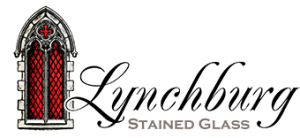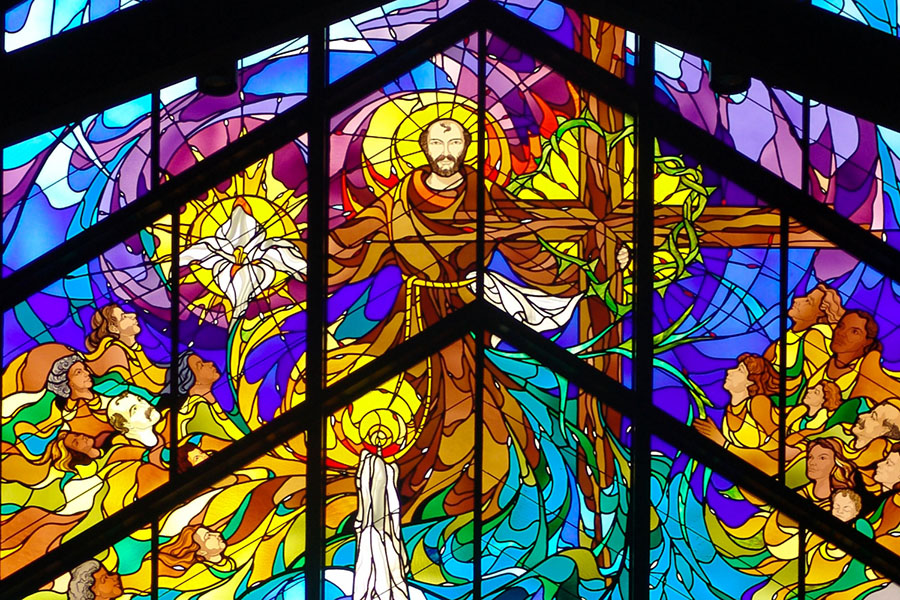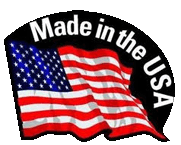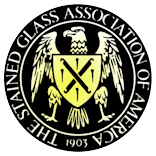Came
Channeled strips of lead, zinc, or other metal used to bind glass pieces within a design. (See Leaded Glass.)
Cathedral Glass
Describes transparent glass that is monochromatic—i.e., single color sheet glass, with smooth or textured surfaces. (See examples on our Stained Glass Types page.)
Copper Foil
Thin, narrow strips of adhesive-backed copper tape used to wrap the edges of glass pieces that have been cut to fit a pattern. Once wrapped, solder is applied, bonding the glass pieces together. Assembling a stained glass project in this manner is called the “copper foil technique.” Louis Comfort Tiffany is credited with its development.
Dalle de Verre
Also called “faceted” glass, dalle de verre is an art glass medium in which “dalles” are broken into pieces with a carbon hammer and set in an epoxy base to adhere them in a decorative design. The technique depends on large scale for best appearance, so dalle de verre is primarily used in architectural applications such as church walls.
Drapery Glass
A relatively common feature in opalescent glass windows, (especially those made by Louis Tiffany and John La Farge), drapery glass sheets have multiple dramatic folds, similar to those present in hanging drapes.
Flashed Glass
Glass of one color with a very thin layer of another color on one side. Flashed glass is often used for etched or sandblasted glass art. When sections of the thin color layer are removed, the base color shows through.
Flux
A chemical agent (liquid or paste) used to facilitate the flow of solder and prevent formation of oxides during soldering.
Jewel
A piece of glass that has been cut and faceted or press-molded into a geometric shape like a jewel. Often incorporated into leaded glass artwork.
Leaded Glass
- Sheet glass pieces joined with metal strips, usually made of lead, called “came.” Solder is applied to the joints of the came to bond the work together.
- Glass containing lead as a raw material (as in “leaded crystal”).
Visit our Virtual Studio Tour page for a brief look at the process of constructing a leaded stained-glass window!
Opalescent (or “Opal”)
This term describes any glass into which a substance (usually fluorine or phosphorus) has been introduced during manufacture which causes a degree of crystallization to occur. Such crystallization creates a milky opacity in the glass. The degree of opacity (and “whiteness”) varies depending upon composition and temperatures used in the manufacturing process. (Opaque white glass is also commonly called “opal.”) Opalescent glass comes in two basic forms:
- Solid-Color Opalescent Glass: Glass which is both colored and crystallized, creating a single-color sheet that is more opaque than cathedral glass.
- Mixed Opalescent Glass: White glass (opal) mixed with one or more other colors to create a variegated, multi-colored sheet. Light transmission varies within particular compositions. Also called “variegated opalescent” and sometimes simply “streaky.”
Opalescent glass was created and popularized in the United States during the late 1800s by both Louis Tiffany and John La Farge. For this reason, opal is sometimes referred to as “American Glass.”
Painted Glass
Glass on which special paints (containing finely-powdered glass called “frit”) have been applied in illustration or decorative patterns. The painted glass is then heated in a kiln to a temperature high enough to fuse the pigments permanently to the glass surface (usually between 1200 and 1400 degrees Fahrenheit). Painted glass comprises the modern version of the original medieval stained glass.
Rondel
A mouth-blown piece of glass that has been spun into a circular shape, often irregular.
Seedy Glass
This effect occurs when cathedral glass entraps air bubbles during manufacture. Air or gas is intentionally injected into the molten glass prior to forming the sheet, resulting in glass that many see as having more character and charm. Visit our Stained Glass Types page to see an example!
Solder
A fusible alloy, usually tin and lead, used to join metallic parts. (Solder is also a verb, describing the act of applying the allow.) Solder bonds metals in both leaded and copper-foil techniques of stained-glass work.
Stained Glass
The term “stained glass” is actually a bit misleading. Stained glass, at its finest, utilizes very little or no “stain” (colored paint). Instead, the color resides within the glass itself: such glass shines far more vibrantly than painted glass ever could. However, the description of glass being “stained” came into common use many centuries ago and persists today. (The term originally applied to colored or clear flat glass cut to fit an artist’s design, on which details were painted in pigment with a brush.) Stained glass, therefore, now commonly describes any colored flat glass or any object made of such glass when joined by metal strips. The phrase is universally accepted as a convenient general term to define the art, the craft, and the industry.



